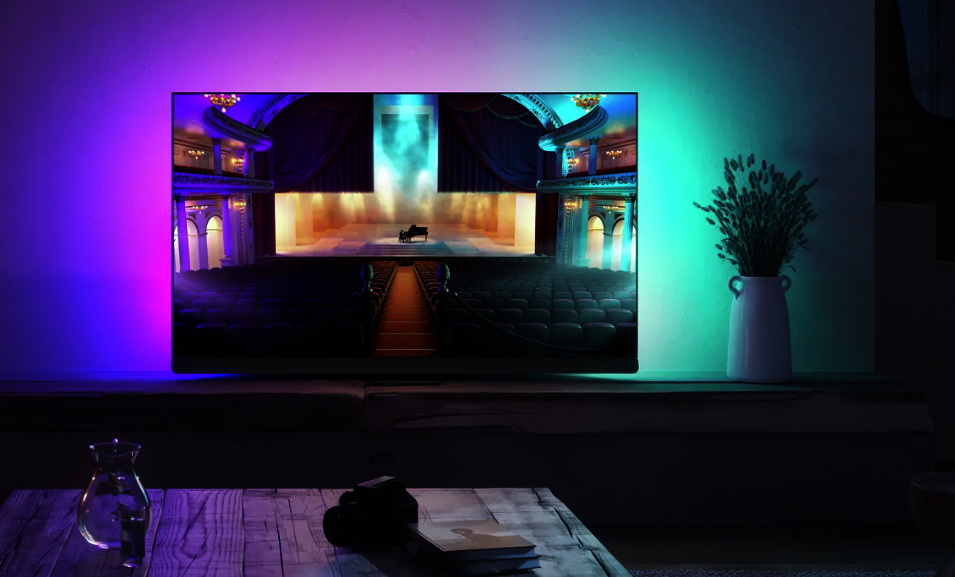TP Vision has announced pricing and availability of this year’s flagship Philips OLED+908 TV, which will be a direct competitor to LG Electronics’s highly-rated LG G3 OLED model.

The Philips OLED+908 was announced at a special event in Barcelona, where the company confirmed it will go on sale at Richer Sounds and other retailers from mid-October. It said the smallest 55-inch model will cost £2,999, with the mid-sized 65-inch model priced at £3,499 and the biggest 77-inch version retailing at £4,999.
Philips hasn’t revealed its European pricing, and the OLED+908 will not be sold in the U.S. or Australia. So it will provide competition for LG’s G3 OLED TV specifically in the European and Latin American markets. The G3 costs the same price at £3,500 for the 65-inch model and uses the same, next-generation Micro Lens Array technology to boost its brightness.
MLA was announced by OLED panel maker LG Display earlier this year and helps to boost the brightness of the displays with its efficiency improvements. By focusing the light of the individual OLED pixels, it’s able to crank up the brightness to more than 2,000 nits of peak performance, up from the 1,200 nits delivered by previous-generation OLED displays.
According to Philips, the OLED+908 can even beat this thanks to its proprietary META brightness algorithm, which squeezes 2,100 nits of brightness, super to LG’s G3.
Other unique features of the Philips OLED+908 include the latest version of the company’s famed Ambilight technology. The three-sided Ambilight uses lights and sensors to create mood lighting effects around the TV that match the content on screen. It also comes with Philip’s most advanced, 7th Gen P5 AI processor, which powers an upgraded Ambient Intelligence system. With this, the set can make real-time adjustments to aspects such as brightness, gamma and colour response to recreate more accurate images on screen. In addition, the OLED+908 also has an improved Super Resolution capability that ensures crisper edges and sharper details, and Smart Bit Enhancement to upscale sub-4K content.
Philips has also put in an integrated 3.1 channel Bowers & Wilkins sound system into the TV, and it’s likely to assure very decent audio quality.
It’s too early to tell if the Philips OLED+908 will be superior to LG’s G3 OLED, but it should certain give it a very good run for its money. HDTVTest had a first look at the set back in February and was very impressed, and our upcoming review will tell us more.
Besides LG, other competitors include Panasonic’s MZ2000, which uses the same MLA-based OLED panel, and Sony’s A90L TV, which also uses a panel supplied by LG DIsplay. Sony, along with Samsung, is also offering a QD-OLED model that many will see as another competitor.
For those looking for a more budget friendly OLED TV, the step-down Philips OLED808 may be a good option when it launches next month in the U.K. That model was originally supposed to launch in August, but problems with Freeview Play meant that it was delayed until October.
Philips said the OLED808 will have 42-, 48-, 55-, 65- and 77-inch sizes to choose from, priced at £1,400, £1,600, £1,800, £2,100 and £3,800 respectively.
Unlike the Philips OLED+908, the OLED808 uses last year’s OLED EX panel so it won’t be quite as bright. On the other hand, it does use the same processor and has the latest Next-Gen Ambilight system. Philips says the 55-inch model can hit a peak brightness of over 1,000 nits. It also has an integrated 2.1 channel sound system with 70 watts of power, and offers gaming features such as FreeSyn Premium and Nvidia G-Sync.
The reason for the delay was that Philips intended for the OLED808 to launch with Freeview Play pre-installed on the TV. The company hoped that by putting its launch date back, Freeview would be able to resolve licensing issues with Google, which provides the Google TV platform that powers the OLED808. Unfortunately, it didn’t, and so the TV will launch without Freeview.
The lack of U.K. video on demand services such as the BBC iPlayer, ITVx and Channel 4 will be a disappointment to some, but Philps said it’s only likely to be a temporary omission and that it should arrive on Google TV sooner rather than later.